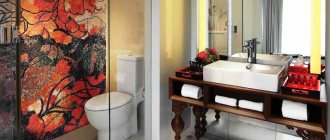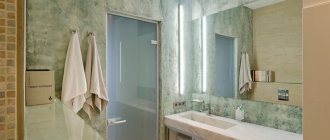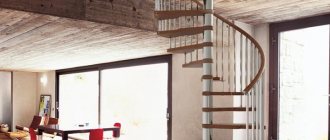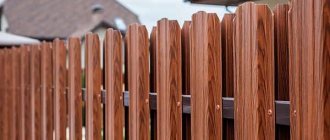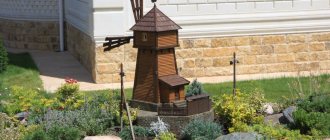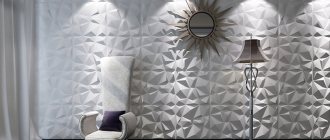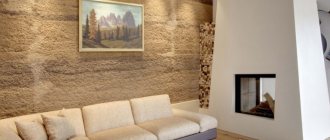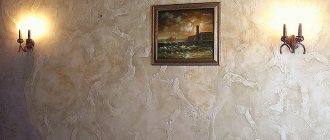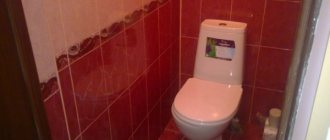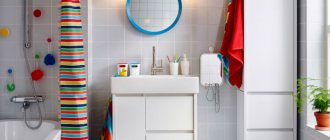Laying features
Wood itself is very attractive, because it has its own patterns and contours.
Wood fibers are always unique, which makes each mosaic element original. Despite the fact that wood is afraid of moisture and does not tolerate temperature changes, many manufacturers of wooden mosaic claim that its characteristics contribute to durability, while maintaining the original appearance.
Not all types of mosaics are durable, for the sole reason that different types of wood are used for their production. For example, pine is a durable material in itself, but it is completely unsuitable for mosaics.
One of the advantages of using wood mosaics for wall decoration is that they are relatively quick and easy to install. However, a few useful tips in this area will definitely not be superfluous. Especially if you have no experience working with such finishing material before.
- The key to successful installation of a wooden mosaic is an ideal base surface, so it needs to be thoroughly prepared: remove all debris and dust, seal cracks with a primer, and, if necessary, level the surface with plywood;
- if you are gluing ready-made mosaic sheets onto plywood, it is best to join them diagonally so that the seams do not separate afterward due to thermal deformation;
- use a special mounting mixture for gluing or parquet glue - classic tile is absolutely not suitable for contact with wood;
- Most often, finished mosaics are sold in the form of sections measuring 30 by 30 cm, 30 by 60 cm, so installation will not be difficult;
- for sealing joints, it is better to choose a safe mineral mixture - it takes into account the hygroscopicity of wood;
- if wooden mosaic tiles for walls are used in a room with high humidity, then a combination of teak on a cork backing would be an ideal option, and the seams can be beautifully sealed with a moisture-resistant sealant.
A video that will definitely help you.
[media=
https://youtu.be/ON-T-1RtDrg
]
Wood is an affordable natural material that is widely used in interior design of various styles. This mosaic will be an ideal home decoration. If necessary, you can choose any shade, of which there are many on the finishing materials market today.
Wooden mosaic is made from small pieces of wood or veneer in a compact format, which usually varies from 1 to 8.6 cm. To firmly secure the wooden elements, a base is used, which is often represented by a mesh. To fix the pieces of wood, special adhesives are used. When making mosaics from wood, they even use shavings, pre-mixing them with water and cement.
Since natural wood deteriorates when in contact with water, the production of wooden mosaics requires the use of oil-wax compounds. They protect the wood surface from adverse environmental factors. Wood mosaic is an original and stylish facing material that designers often use to decorate walls and floors. It is needed to implement the most unusual and original design ideas in the interior.
Wooden mosaics are often used in living rooms, bedrooms, kitchens, as well as rooms with high humidity: bathrooms, saunas and baths. It is great for decorating offices, restaurants and cafes. It is often used to hide uneven walls. It is great for zoning a room and can be used as an accent when decorating the interior in the chosen style. Wooden mosaic is presented not only in the form of small squares, it can be rectangular or curved.
New set!
Glass mosaic course “Table with lilies” (We accept applications)
The course is designed for 5 lessons (from 11-00 to 17-30), 1 or 2 times a week (possibly more often by agreement with the group). Experience working with glass is desirable, but not required. We provide all materials and tools, including an apron, glasses and gloves. During the break there is a coffee break. The cost of the course is 20,000 rubles, including materials.
Table size: height 62 cm, diameter 48 cm.
For our regular friends who attended the mosaic master class, the cost is 18,000 rubles.
Advantages of mosaic
This finishing material has many advantages, wood mosaic:
- is an environmentally friendly material;
- characterized by a long service life;
- is a fairly warm coating (it can be used for floors);
- differs in thermal insulation properties;
- goes well with other surface finishes.
The choice of mosaics is currently very large, so choosing it for the bathroom is not entirely easy. In the case of combining a bathroom with a toilet, it is necessary to improve ergonomics in the equipped areas. In addition to thinking about where and what will be installed - a bathroom, a shower stall, you also need to calculate the points where the lighting will be located, the design of the mirror, hangers, etc.
The entire design should be based on the same color shades or completely contrasting solutions. In terms of texture and color, the selected decor should have something in common with the installed plumbing fixtures (sink, shower stall, bathtub) and ceramic tiles. Most bathrooms have a small area. In such cases, mosaic comes to the rescue, since rooms made with its help are visually enlarged and seem lighter.
Choice of color, styling and decor
Let's look at some interesting solutions:
- Using the same shades. The effect is achieved if all surfaces are made using the predominant color. There are no contrasting inserts, but there is a background close to the main one.
- Contrasts. The opposite scheme. There are contrasting splashes against the background of a single color. The combination of tones can be different: black with white, red with white, gray with yellow, yellow with blue. The main factor is the combination of shades with each other. To avoid mistakes, it is recommended to use Itten’s color wheel or take one of the universal colors as a basis.
- The variety of mosaics allows you to recreate not only geometric shapes and compositions, but also full-fledged designs.
Color combination of mosaic tiles for the bathroom Source happymodern.ru
Mosaic color combination Source 2gis.com
Combination of mosaic shades in the bathroom Source vplate.ru
An original, but not practical method of interior decoration Source: mosaic-cafe.rf
Advice! An original solution would be a mosaic panel on one of the walls of the bathroom. The project is carried out by selecting pixels of different shades.
What types of wood are used
There are many options for wooden wall mosaics, but its tonal characteristics, price and overall expressiveness most often depend on the type of wood that was used for cutting. Let's consider a variety of options.
- pine is the cheapest option, but by no means in terms of visual expression, it differs from the others in its specific spiral pattern - have you ever tried to determine the age of the tree from these circles?;
- aspen is a practical, easy-to-process type of wood with a characteristic yellowish tint; it is not always used due to the fact that it is a soft wood;
- walnut is a medium-cost option that has a wide range of colors and is often used to decorate walls in a wooden cottage;
- linden – only young trees are used to produce mosaics, as they tend to decay over time;
- bamboo is a good compromise between price and quality, fits perfectly into any modern interior;
- oak is a common hardwood for making mosaics and is considered one of the most successful options;
- ash, cedar - a couple more hardwoods, are not cheap, but look great in a wide variety of rooms.
We invite you to familiarize yourself with the Pipe box in the bathroom: the best options to hide pipes in the bathroom
In general, hardwoods are the most prized wood for mosaic production. However, this does not mean that all others are ignored: both pine and linden, which belong to the class of soft species, are quite suitable for making so-called saw cuts. But in order to make a complex mosaic of marquetry from various fragments, you should focus your attention only on hard rocks.
Modern wooden mosaics are made from the following types of trees
- wenge;
- oak;
- maple;
- ash;
- merbau;
- cedar;
- alder;
- nut.
Whatever wood is used to produce wooden mosaics, it acquires true strength only after it is coated with oil-wax impregnations.
Thanks to these impregnations, mosaics can be installed in rooms with high moisture, for example, in the bathroom or kitchen. There is only one thing: wooden mosaic should not be in constant contact with water, otherwise it will collapse and become unusable over time.
Features of the technology for laying wooden mosaics on walls
This material has a number of advantages:
- Excellent for finishing walls with uneven surfaces that are difficult to level.
- It's warm.
- Environmentally friendly.
- With a long period of operation.
- When combined with various original and unique ornaments, a fairly large versatility is ensured.
Wooden mosaic can be of two styles, which differ in manufacturing technologies:
- Intarsia. This technique for decorating wooden mosaics is quite labor-intensive and complex. In this case, all individual fragments of it or a set of individual pieces of wood are cut into a wooden base or surface using a wide variety of colors and textures of wood species used.
- Marquetry. At the same time, unique and complex mosaic designs or compositions are created with pieces of veneer. The creation of the future composition is carried out taking into account the direction of the fibers, color shades and fractal properties of the wood.
A competent selection of wood allows you to give the mosaic cladding:
- Durable in use.
- Durability.
Tip: Such favorite types of wood as pine and linden cannot be used in a mosaic composition.
Hardwood species are used for wooden mosaic walls and floors:
- Cedar.
- Ash.
- Maple.
- Alder, in small quantities due to the absorption of negative energy into it, while being, as it were, a cleaner in nature.
Mosaic can be made from wood waste - shavings, which are mixed with a mixture of cement and water, after which the mass is given the desired shape, thickness and density.
In this case, the material:
- It has a gray-yellow-orange color.
- Attached to the surface with glue.
- Folds perfectly into a beautiful pattern.
- Has a low cost.
- Has high strength.
- Fire and moisture resistant.
- Soundproof.
- Quite unpretentious in care.
When special impregnations, waxes and oils are used to protect finished wooden mosaic products, it can be installed in the kitchen and bathroom.
Tip: Do not cover areas of the walls and floor of the room with wooden mosaics that are constantly exposed to water.
The technology for laying mosaics made of wood has the following features:
- To simplify installation, sections of wooden mosaic have dimensions of 300x300 millimeters.
- For such material you cannot use ordinary glue.
- When gluing mosaic tiles onto plywood, the sheets should be joined diagonally to prevent visible divergence of the cladding along the butt seams during thermal deformation of the material.
- When finishing seams, it is not recommended to use ordinary grout used when processing seams between ceramic tiles. In this case, a special two-component epoxy grout is used, designed for grouting joints between hardwoods. This is due to the fact that when grouting ceramic tiles, they do not bend or deform, and when using wood, from the slightest fluctuations in the material - when temperature and humidity change, the wood begins to “breathe”, the mineral grout will begin to crack and crumble, and it needs to be washed off large amounts of water, which can damage the wooden mosaic.
- The floor is finished with teak mosaic on a cork backing. The thickness of the boards for the floor is 7 millimeters, and for the walls no more than three millimeters. Such a floor must be sanded many times, and all joints in the floor must be filled with silicone glue.
- The service life of the floor is calculated in decades.
- When caring for wooden mosaics, wipe them with a damp and then dry cloth every 7 days.
The harmonious combination of the geometry of patterns and colors of mosaic elements has not lost its uniqueness and is used for decorative design of residential premises and building facades.
Wood is one of the first materials that man began to use for building and decorating a house. Thousands of years have passed since then, but the love for the warmth of the cut and natural shades of wood has not disappeared anywhere. Moreover, in recent years, designers have been actively looking for new options for using their favorite material. And the design of wooden mosaic tiles is one of such bright and bold experiments.
Varieties
Today, many manufacturers offer interesting and beautiful wood mosaics. It is presented in several types: marquetry, intarsia, instruction and block. Each of these technologies is carried out using veneer. In one case it is simple; in other production methods, figured ones are used.
When working with simple veneer, it is easy to choose the direction of the fibers and color, because when laying it, the same direction of the wood fibers is used. If you use figured veneer, you must adhere to the pattern made on the surface of the mosaic elements. To create an original interior, you can use veneer in different colors. When laying it, you should adhere to a specific geometric composition (this way the design will be spectacular).
Using the technique of laying marquetry, you can combine original compositions, which will be based, for example, on a unique ornament or design. It is worth noting that the design itself may be asymmetrical and may not correspond exactly to the geometric shapes. Inlay and intarsia have much in common. The main difference between these two techniques is what additional material is used to combine with wood.
The instruction technology involves the inclusion of inserts made of stone, metal, colored glass, mother-of-pearl or bone. When using the instructions, wood veneer is combined with expensive finishing elements that match in color and structure. Inserts made from other materials are used flush with the wood or pressed into the surface, thereby creating a relief texture.
Depending on the type of base, mosaic tiles vary. Let's look at the main varieties:
- On the grid. Manufacturers produce a ready-made set of elements in the form of squares attached to a grid, which are subsequently laid on the walls. This option is great for working with curved surfaces.
- On paper. A certain set of mosaics is fastened on the front side with paper, which holds them in that order. After laying and the glue has completely dried, the paper on the mosaic should be carefully moistened with water to facilitate the process of removing it.
- Without reason. This option is suitable exclusively for professional craftsmen who use elements of different colors and wood textures to realize original compositions.
Zoning, partial finishing
Mosaic in the bathroom looks impressive, but such an interior is not suitable for every room. It is quite difficult to create a beautiful pattern in the bathroom of a typical economy class apartment. Therefore, it is recommended to use the technique of partial cladding, the so-called zoning.
Plumbing finishing. One of the rarest but most successful techniques. Only an experienced craftsman can perform such work efficiently. Quite a stylish option for using mosaics in the interior of a bathroom. However, the joy of what you have done may disappear in the first days of operation: the seams between the pixels will have to be cleaned very often.
Shower tray lined with mosaic Source plitkahelp.com
Bathroom screen, shower tray. In most cases, the space is lined with the material remaining after finishing the walls. But a surface decorated with mosaics will look much more luxurious. Especially if it is not straight, but curved in a semicircle. It is not necessary to cover the entire area of the screen; even a narrow decorative strip will bring results.
Advice! The full effect is achieved by extending the screen onto part of the wall. For example, the mosaic used below may be present in the form of a small decorative insert.
Mosaic decoration of a bathroom niche Source sunrem.ru
Niche. This solution will be most relevant in bathrooms with ventilation ducts or other engineering structures that disrupt the even plane of the walls. Mosaic, as an option for facing such places, is not only an advantageous aesthetic step, but also the most acceptable from a practical point of view. Finishing these elements with other materials will require a lot of adjusting and trimming. Therefore, paper-based mosaic tiles will be one of the best cladding options.
Mosaic edging of the bathroom mirror Source vplate.ru
Mirror edging, door. The mosaic favorably accents the mirror located on a plain wall. This technique can be duplicated by similar installation around the doorway. The color of the edging does not have to differ from that used for finishing the main surface of the walls. Thanks to the small pixels, the difference will be visible due to the seams between them. This is what creates the effect of the intended accent.
Tabletop covered with mosaic Source interiorno.ru
Washbasin countertop. This is where you get the opportunity to save money. Resistant to moisture and mechanical damage, the mosaic will become an excellent “protector” of the tabletop. It, in turn, can be made not from high-quality moisture-resistant material, but from an ordinary moisture-resistant chipboard or OSB sheet. After assembling the structure, the surface is covered with tiles, which will take the main loads.
Healthy! When tiling the countertop of a bathroom sink, consider tiling the backsplash underneath at the same time. From a practicality point of view, this will be a beneficial solution.
Nutshell
In addition to trees of various species, walnut shells, which are incredibly durable, are also used to produce wooden mosaics. In addition to its strength, walnut shells also have an interesting texture that looks great on the wall in the form of a wooden mosaic. In addition to texture, shell mosaic also has a relief, which gives it an unusual look.
Shell mosaics are laid in different ways, both in a row and in a herringbone pattern. The shell absorbs moisture well, like any wood, but it gives it back just as easily, so this mosaic can be used in rooms with high humidity.
Practical and decorative properties of mosaic
- Stone mosaics have undeniable aesthetic qualities and will become a harmonious addition to the interior design of almost any room. These are ample opportunities for the designer's imagination to fly.
- Natural stone is not afraid of moisture or temperature fluctuations, so its surface will not be affected by fungus or mold, even if it is used to line a room with a high level of humidity.
- Stone mosaic will not lose its aesthetics over the centuries, since natural stone does not fade in the sun, does not lose its color and is not afraid of high or low temperatures.
- Natural stone does not require special care.
- Stone mosaic, the price of which consists of the cost of the material and facing work, is an absolutely non-flammable and environmentally friendly material used as cladding for the facade of a house.
Mosaic made of natural stone at the best prices today and always in our offer
General characteristics of the finishing solution
Of course, this solution is new only for the modern market, which is fairly crowded with materials for finishing walls and floors that are good from all points of view. In the context of the entire development of civilization, wood has always been used in the interiors of both the most ancient palaces and buildings, and more recent architectural structures.
We invite you to familiarize yourself with Tiling work in the bathroom
From the perspective of not ancient times, but precisely today, let’s try to list all the advantages of using this finishing solution:
- helps hide uneven walls;
- environmentally friendly;
- long service life;
- goes well with other decorative elements and decoration;
- brings variety and homeliness to the interior;
- easy to repair;
- is one of the most affordable ways to create a beautiful three-dimensional relief in any room.
An alternative option is 3D panels, examples of interiors with which you can see in the article: “3D panels for walls: the most interesting and new ideas.” Such a mosaic is obtained in two ways:
- made of solid wood;
- made from wood chips mixed with water and cement.
This is not to say that one of these options is significantly better than the other. Although wood mosaics are much more expensive and generally look more solid and attractive. In an adult way, let's say. The shavings, however, have their undeniable advantages:
- low price;
- good moisture resistance;
- simple care.
But you yourself understand that in the end it’s not even the initial characteristics that decide, but the direct implementation in a specific interior.
Wooden mosaic surprises with its variety of natural shades. Its color depends on the type of wood used. Exotic trees look attractive and unusual. Wood mosaics are usually made in shades of brown. For example, ash is used for lighter tones, oak for darker shades, although today one of the most popular tones is the bleached tone of light wenge oak.
The mosaic surface may include elements of one or more tones. Light compositions are ideal for small rooms as they allow you to visually enlarge the space. Dark panels will help create a bright accent in the interior of a spacious room. Compositions that include light and dark elements and a variety of textures look impressive and original. This composition will become an interior decoration.
Technology for laying glass decorative mosaics
We're talking about modular mosaics; we'll leave the production of artistic panels to the professionals. Mosaic tiling is more labor-intensive than working with regular tiles. Often, due to the cost of the material, even “golden-handed” craftsmen do not risk dabbling with puzzles right away, but turn to tilers for help. But, no matter which method you choose, it is useful to understand the aspects regarding mosaic work.
Decorative glass mosaic has either a paper or polymer mesh backing. This is a very important difference that affects the installation method. The mosaic components are glued to the paper with the front part, respectively, glass is glued to the base. The elements are glued to the plastic with the back side, so here they do the opposite - glue is applied to the walls/floors and the polymer. The paper version requires additional effort to remove the backing after lining. This is done with water - the mesh is easily removed.
The choice of glue is also a serious aspect. The mixture should be:
- highly adhesive;
- moisture resistant;
- frost-resistant (if appropriate use is intended);
- white or colored (to match the mosaic);
On our website you can read recommendations for laying tiles in general. Here are tips for working with mosaics. Stages of work:
- Surface preparation. The foundation must strive for the ideal - the mosaic does not tolerate anything else. The finished surface must be primed.
- Marking. It is not much different from ordinary situations, with the exception of more frequent “decorative” situations, and therefore, possibly, more starting points.
- Facing. In the case of mosaics, the glue is applied to the base using a notched trowel with fine teeth. The difficulty of installation lies in the need to maintain acceptable seams. Modules themselves often suffer from some displacement of elements. Add to this the other parameters - it’s not easy for beginners in this business. The glued matrices should also be aligned on a plane; this is done in different ways: using plywood, as a rule...
- Mosaic cutting. The modules are cut with a regular knife or scissors. As for glass, a grinder can help. But you need to be careful - glass is very fragile.
- Cleaning seams. After the glue has set, each seam must be cleaned of the mixture.
- Grout. Choose a puffer with high adhesion. Epoxy grouts are best suited for mosaics.
Collection examples
Let's not lie: choosing your collection is not an easy task. Whatever option you take, everything will benefit the interior. Manufacturers offer an abyss of textures, including luxurious “gold”, “silver”, wood, stone and other, no less alluring, variations. We will not risk imposing any solution. But it won’t hurt to go through a short list of the collections.
- Adriatica is a Chinese mosaic from the Natural Mosaic company. A great monochrome option. More precisely, the options are included in a variety of colors, each of which is represented in several shades.
- Bruma is a Spanish mosaic from Mosavit. Classic aquathematics - blue chips strive to end up on the walls and floors of the bathroom.
- Drops – mosaic from Art&Natura (Italy). Looking at the iridescent “stones”, you understand how rich the mosaic world is!
- Kerion Luxor is a Portuguese mosaic from the company Kerion Mosaics. Luxurious finishing material - and you can see it all for yourself!
Alas, the article must be incredibly voluminous to have the right to be called a guide to decorative mosaic collections. Therefore, on this note, we will leave you in anticipation of a pleasant journey through the mosaic catalog. We are sure that your fantasies will not be able to bypass the realities.
Bamboo
Bamboo is also used to create wooden mosaics. Frankly speaking, it looks much worse than a mosaic made of wood or shells. Perhaps this is expressed by the fact that bamboo is still not a tree, but a grass. Mosaic made from this material is much softer than wood, so it is more susceptible to all kinds of chips and scratches. It is not recommended to use such a mosaic in rooms where children play, because it will quickly lose its original appearance.
What to consider when choosing?
In large construction stores and supermarkets you can choose a mosaic for the bathroom to suit every taste. Here you will be asked to imagine what the final bathroom design will look like. Various themes can be applied to the material. Squares with sizes of 5x5 cm, 2x2 cm and 1x1 cm are very convenient for masonry.
Mosaics come in various shapes:
- oval;
- diamond-shaped;
- rectangular;
- square.
If the bathroom is not combined with a toilet, you should select panels, thereby dividing the space into zones. You can decorate the room with a mosaic in the form of multi-colored waves.
This material is considered noble. It is convenient to cover a surface of any shape - oval, round; it is practical and convenient to work in rooms where the walls are not very smooth.
With the help of mosaics, the room acquires an original design. Built-in shelves, baseboards, steps, finished with this material will give the room a color of luxurious depth and introduce man-made drops into the space.
The marine color scheme is beautifully combined with a suspended glossy ceiling and plain tiles. In the interior of the bathroom, it is better to place small mosaics on the steps, floor and walls. And you can complete these touches with neon or LED lighting. It looks beautiful when such light repeats the shade of the mosaic.
To choose a high-quality, reliable and practical wooden mosaic, experts recommend paying attention to several nuances:
- The mosaic has markings that indicate the strength of the product. The best option is the first grade, which is indicated in red. If you are looking for an inexpensive but quite practical solution, you should pay attention to the second grade, presented in blue. The least durable is the mosaic with green markings.
- When choosing a wooden mosaic for flooring, it is worth purchasing an option with high wear resistance and anti-slip properties. Manufacturers designate this effect for floor use with a pattern in the shape of a foot.
- If the mosaic must be resistant to aggressive environments, and you plan to use it in the bathroom or kitchen, then the packaging should be marked in the form of a flask.
- Before purchasing, it is worth taking measurements of the surface that you plan to decorate with mosaic tiles in order to make correct calculations of its quantity. It is always necessary to add another 15% in reserve, since defects occur, and mosaics from another batch may differ in shade.
- When choosing a color, you should start from the chosen interior design; you must not forget about personal preferences.
Choice for a spacious bathroom
When decorating a large bathroom with mosaics, it should be taken into account that in this situation, space can lead to the loss of the feeling of comfort and homeliness. Therefore, the technique of visual narrowing is used here in order to make the environment more “domesticated”.
Do not use plain wall cladding. This will lead to the fact that you will get a dull interior, which even bright decorative elements cannot correct. It is best if only opposite walls are finished the same way.
Another option is to divide the room into functional areas: shower, sink, toilet. The main emphasis is on light colors, dark ones are used as cladding, to give an accent.
Example of smalt mosaic Source www.tileideaz.com
Metal mosaic in the bathroom interior Source dekoriko.ru
An example of laying mosaics in a large bathroom Source roomester.ru
Glass mosaic in the interior of a spacious bathroom Source plitkahelp.com
Advice! Monochrome or contrasting mosaic compositions, harmoniously combined with the overall style, will beneficially enliven the entire interior.
Wooden mosaic - natural materials in decoration
When listing the types of mosaics, most of us will not even remember that wood mosaics exist. And it’s not just being produced - wooden mosaics are gaining more and more popularity. Well-known foreign and Russian companies are investing in the development of the production of wooden mosaic tiles, and competition in this segment is increasing every year. This is a benefit for the consumer - technologies are improving, prices are falling, and today many people can buy wooden mosaics.
We suggest you read: How to remove old paint from a bathtub
Note: a mosaic is an ornament or image assembled from small elements (pieces) of the same or different materials and fixed to some surface.
The classic solution for using wood mosaics is to decorate walls. It can be used to decorate one wall, thereby zoning the room. You can use it to highlight a sleeping area, smooth transition from one to another room, and design a place to relax.
The mosaic looks impressive in spacious rooms when it is used to decorate a huge canvas. In this case, you can examine the texture of the wood and see the play of shades. Wooden mosaics are used to create floor coverings. It looks impressive and original. It can be used to decorate staircase steps and furniture. It looks attractive on the table.
For example, you can:
- lay tiles around the bathtub or shower stall on the walls and floor;
- use a combination of mosaics in tandem with ceramic tiles, which will allow you to create original decor at minimal cost;
- decorate one wall with an unusual ornament or pattern from a wooden mosaic (a panel of different colors, a geometric pattern or an attractive landscape);
The built-in shelves, lined with mosaics and additionally decorated with lighting, look original. A bathtub lined with mosaic tiles on the outside looks impressive. You can decorate the mirror or washbasin area with an interesting accent.
Mosaic material
Once upon a time, smalt was used to make mosaics as the most natural raw material. Smalt is a naturally formed glass, the color of which is directly dictated by the predominant mineral components. The next type was marble, as a result of which both products were available only to wealthy people. Decades later, technology has changed. Now there are opportunities to make mosaics at a cost per 1 m2 comparable to the price of not very expensive tiles. Modern mosaic is made on the basis of artificial glass, with the inclusion in some cases of mica, which can change its appearance.
Mosaic can have a variety of shapes
The quality of mosaics made from artificial raw materials is slightly inferior to natural mosaics, but their cost is also incomparable. At the same time, decorative mosaic is also strong and resistant to moisture.
How to install wooden mosaic tiles
The most important point in installing wooden mosaics is the surface. It must be perfectly flat, otherwise the mosaic will follow the relief of the wall. Therefore, the walls must be made either of plasterboard or well plastered and puttied.
Don't forget about the primer either. In order for the mosaic to adhere well to the wall, it must be thoroughly primed to increase adhesion.
Not only should the walls be smooth, they should also be free of cracks and bumps, so it is recommended to use finishing putty for leveling.
When installing wooden mosaics, pay special attention to the level. Strictly define the horizon and vertical and mark them on the wall. While laying the mosaic, keep an eye on these planes.
By and large, laying a wooden mosaic is reminiscent of laying a regular mosaic or tile, but there are some nuances.
First, ask the consultant at the store where you will buy the wooden mosaic whether there is a special glue for sale for it. The glue must contain PVA - this is the basis for good contact of the mosaic with the wall.
I would also like to warn you about the seams between the mosaic pieces. You should not grout these seams with regular grout. The fact is that wood, no matter what it is, is capable of “breathing,” which will cause all the grout to soon crack and lose its original appearance.
Special grouts designed for wooden materials are available on sale. They are able to expand and contract, thereby preventing cracks from appearing on them.
If you can’t find a special grout for wood mosaics on sale, then use ordinary silicone sealant, choosing the appropriate color. Today, there are quite a lot of sealants on store shelves that are not afraid of contact with water and at the same time have different color palettes, and not just white.
Cons of mosaic
Like other facing materials, mosaic also has disadvantages. Firstly, it's cost. Material from branded companies is not affordable for everyone, and material produced in the Celestial Empire is also not suitable for everyone.
The second point is related to the complexity of installation. If we talk about a small area of the wall surface, then, even with modest experience in repair work, it is quite possible to lay the mosaic with your own hands. But huge surfaces require significant work skills.
Even experienced tile workers do not always have sufficient qualifications to work with mosaics, so finding a suitable worker with recommendations is not easy. Of course, this type of work will have a much higher price than laying standard tiles. However, the final result is definitely worth it.
Beautiful use cases
Wooden mosaic looks beautiful and original in the interior of various rooms. It allows you to create an interesting composition, divide into zones, and place accents.
- When decorating a bedroom, they often decorate the wall at the head of the bed with a luxurious panel. A mosaic made of rectangular elements with a relief surface will give the room coziness and comfort, it promotes relaxation.
- Wood mosaic with varnish can be used to decorate a kitchen apron. Small mosaic looks attractive, it blends harmoniously with the stone countertop and has an original texture.
- Using a wood mosaic impregnated with a fire-resistant compound, you can emphasize the location of the fireplace in the living room. The relief texture will give the interior spectacularity and brightness.
To learn how to lay wooden mosaic tiles, see the following video.
Designer tips
Before gluing mosaics to the walls, it is recommended that you familiarize yourself with some design tips:
- A wall decorated in this way can participate in the zoning of a room and create a bright accent that attracts attention;
- Mosaic elements differ not only in shade, but also in shape, which allows you to create the necessary optical effect in the room. Thus, oblong bars, laid vertically, will visually increase the height of the room;
- The expressiveness of the texture and shade are chosen depending on the area of the room. The larger the room, the more prominent the natural texture of the wood can be;
- To create an effective composition, a combination of elements from different types of wood, differing in natural shade and texture, is used;
- When using such decor on the surface of a fireplace or in damp rooms, the material is first treated with special protective compounds in accordance with the operating conditions.
Do not be afraid that wooden mosaic will be impractical - the high cost of the decor will pay off due to the long term.
The video in this article will tell you how to lay mosaic walls in the bathroom.
Since ancient times, mosaics have been used to decorate various rooms, allowing them to be diversified and bring something new into interior design. Wooden mosaic allows you to decorate any interior. It is used to decorate floors, walls and even furniture. It looks great not only in classic style, but also in avant-garde and modern ones.

